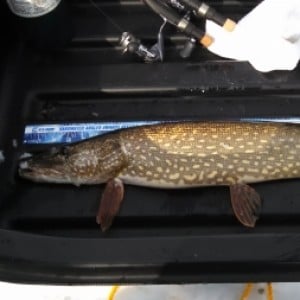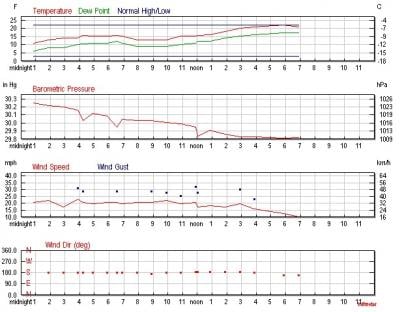I’ve heard of guys saying fishing is better at certain pressures. I was wondering what type of pressures are better or worse. Also is was wondering what I could use besides a barometer to monitor pressures (ie websites, iPhone apps). Any info would be great. Thanks
IDO » Forums » Fishing Forums » Ice Fishing Forum » Barometric pressures
Barometric pressures
-
January 7, 2014 at 9:18 pm #1378054
Typically I’ve always been told that predatory fish (walleye, musky, bass, even big trout) hunt more during low pressure. Couple possible explanations being that a.) Low pressure typically means a storm is coming or its going to rain and fish eat before they lay low.b.) I have even been told that with lower atmospheric pressure fish are able to move more fluidly through the water thus they hunt more?
January 7, 2014 at 9:46 pm #1378059I’ve also read panfish tend to prefer a stable stretch of weather. It can be negative 40 as long as that pattern has been in place for a couple days they will feed. That said the best day of crappie fishing I ever had was after a cold stretch in the end of February. It was around 0 degrees for 3 days straight. I woke to 30 degrees and drove to bayport. At first light I had only 2 bites in an hour and a half. Around 830am it started to mist and it was game on. I couldn’t even fish two rods it was so frantic. After about 30 minutes I already had 25 in a 5gal pail with water in it. I was throwing smaller fish back to keep bigger ones and throwing everything 13″s + back as well. A friend showed up and got his limit in another 20 minutes. We wanted to keep fishing even though we were done keeping fish because we had never caught fish at that level before. However, soon after we had filled our limits it started raining a little bit harder they completely shut off.
January 8, 2014 at 2:14 am #1378067Go to localconditions.com….type in your city and state,then click on past…it will show you the barometer,wind,and temp by the hour from the current readings all the way back to the seven previous days..best weather history site hands down..
 shamusInactivePosts: 317January 8, 2014 at 5:16 am #1378074
shamusInactivePosts: 317January 8, 2014 at 5:16 am #1378074Quote:
Go to localconditions.com….type in your city and state,then click on past…it will show you the barometer,wind,and temp by the hour from the current readings all the way back to the seven previous days..best weather history site hands down..
Those sites are handy because you can see what the barometer and all other stuff was doing at the time the fish were biting or not. wunderground.com is another site that has historical data but it has daily and hourly data going back to 1998. Click the “almanac” tab in middle of the page. Then after that loads click the “View more history data” link at the lower right hand corner. From there you can change the month, day, and year at the top of the page.
Oddly enough, the last couple of times I’ve been out the panfish started biting aggressively when the pressure was on the rise. Not drastic changes in the barometer, but it was rising. I thought the falling barometer was better for a good bite, but maybe I’ve heard wrong.
January 8, 2014 at 6:35 am #1378091Solunar tables are also a good reference to predict feeding windows. You can do a search and look at a few different ones and put a plan together.
January 8, 2014 at 7:28 am #1378119Quote:
Go to localconditions.com….type in your city and state,then click on past…it will show you the barometer,wind,and temp by the hour from the current readings all the way back to the seven previous days..best weather history site hands down..
Awesome, just what i was looking for. I have actually been keeping track of the B pressure on a peice of paper for the last couple weeks. however its nice to have the hourly.
 Ekez
Posts: 80January 8, 2014 at 8:57 am #1378155
Ekez
Posts: 80January 8, 2014 at 8:57 am #1378155I just took a look at the pressure reading from yesterday at wunderground.com and we caught most of our fish from 8 until 10am. Here I thought the pressure dropped a little and it actually was rising. And when the fish shut off at 10:15 it started to drop agian. Weird. I have always done better on low pressure days. I guess sudden changes trigger a bite as well.
January 8, 2014 at 12:29 pm #1378245Like the rest of you, I’ve spent quite a bit of time referring to barometric pressure changes as well. The problem is that with so many other variables to account for, it’s difficult to pin activity levels on barometer alone. There’s moon phase, predator/prey relationships and the timing that goes along with them, along with everything else from current to clarity.
What I will say, is that I tend to prefer looking at graphical representations of the barometer. You can get these from NWS stations, and look them up for your area via wunderground.
My favorite times to fish, when given the option and all else being equal, is anytime the barometer has made a long slow climb over a few days and is starting to peak, shoulder, and start heading back down. This is most often the fastest fishing, especially when paired with low-light periods that are usually high-activity. A close second however, is after several days of a relatively stable barometer, especially slowly climbing. Rapid anything is bad, so steep slopes on the barometer graphic make it difficult for you. You see that alot during the summer when you’ve got those high fronts coming in every day or two.
Steady weather or just before the bottom falls out are typically good, but there are a pile of other factors which can cloud or even erase the effect of barometer. At least that’s what I’ve observed.
Joel
 January 9, 2014 at 3:39 pm #1378652
January 9, 2014 at 3:39 pm #1378652This is some great information and I have learned a bit from it. I have such limited time to fish that I am just gonna go when I have the time and deal with the conditions. Even a bad day of fishing is better than a great day at work.
Thanks
BobJanuary 9, 2014 at 6:15 pm #1378680So wondering if these are the spikes Joel was talking about. This was for bitter lake in SD today. So if I understand right the spikes usually make the fish stop?
 January 12, 2014 at 7:51 am #1379139
January 12, 2014 at 7:51 am #1379139Quote:
This is some great information and I have learned a bit from it. I have such limited time to fish that I am just gonna go when I have the time and deal with the conditions. Even a bad day of fishing is better than a great day at work.
Thanks
Bob
Bob – I think that’s the best advice from all of this. Fish when you have time, as there’s lots of confounding variables which can swing the bite aside from pressure changes. If given the choice, by all means stack the odds in your favor, but don’t pass up a day of fishing!

Joel
January 12, 2014 at 7:57 am #1379140Quote:
So wondering if these are the spikes Joel was talking about. This was for bitter lake in SD today. So if I understand right the spikes usually make the fish stop?
Actually, what you’re seeing there has the makings of a pretty good morning bite. The barometric pressure dropped there from middle of the night all the way through the day. That fall in pressure usually signals a pretty aggressive feeding window. Fishing can be pretty tough once it levels all the way out and pressure stays really low, or after it rises quickly and immediately stays high.
The spikes I’m talking about are just like you’re seeing but over the course of a day or day and a half. Think peaks and valleys across the entire graph. The spikes you’re seeing in that graph look like faulty recording equipment.
Again, this is with all else being equal, which rarely is the case. Hungry fish due to limited prey and/or population imbalances can cause more sustained bites.
Joel
You must be logged in to reply to this topic.